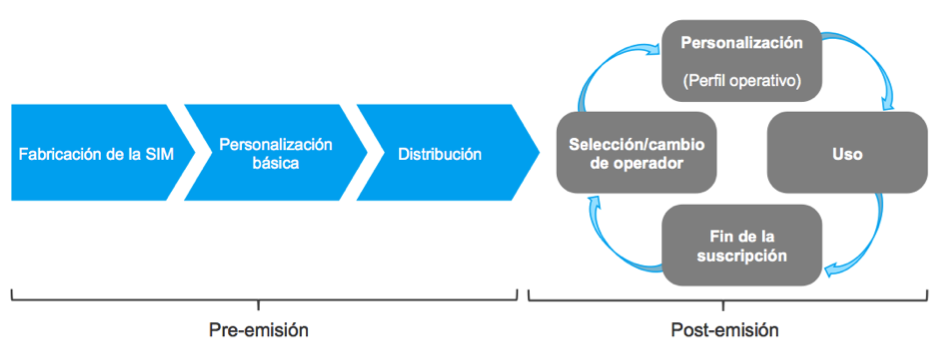Article
What is #eSIM, how does it work, and what opportunities does it offer?

GSMA makes progress in the standard of the embedded SIM, which is essential for the #IoT
eSIM (Embedded Subscriber Identity Module) is an extension of the existing SIM technology, but in this case, the actual chip is already integrated in the device.
GSMA, the association that represents most telecommunications providers, began working on defining the standard in 2013. In early 2016, it published the initial specifications for guaranteeing interoperability between carriers, manufacturers, and platforms.
An embedded SIM has the same functionality as a removable SIM, but in a different manner: the chip is permanently welded into the device. It has eight electric pins, just like the eight contact points of a current SIM. Since it is not removable, the profiles of new telecommunications providers are downloaded when needed and in a secure manner, Over the Air (OTA).
The SIM for machines and wearables
The eSIM concept is considered to be essential for the development and evolution of M2M (Machine to Machine) and the IoT. According to the Ericsson Mobility Report, of the 28 billion connected devices that will exist in 2021, more than half will be for the Internet of Things.
Production is cheap, and due to its small size, it easily adapts to the growing market of the IoT. Its size allows it to be implemented in wearables or small devices, and in terms of manufacturers, it represents a single design with a global and lasting reach (more than 10 years).
The majority of existing devices capable of using 3G/4G networks only use WiFi, and the eSIM will prevent wearables such as watches to depend on a smartphone to connect via Bluetooth for example.
A change in the SIM life cycle
The embedded SIM concept represents a change in the linear model that is used today…

…To a results-based model with remote provisioning:

The ecosystem includes two new entities
In the architecture of a basic embedded SIM system, two managers are added to the manufacturer of the chip—known as the eUICC or Embedded Universal Integrated Circuit Card—and to the wireless telecommunications provider:
The Subscription Manager – Data Preparation (SM-DP), which securely packages and manages the installation of the profiles to be provisioned to the SIM.
The Subscription Manager – Secure Routing (SM-SR), which guarantees the secure transport of the SIM’s management commands for loading, activating, deactivating, and deleting profiles.
How do profiles work in an eSIM?
An eUICC can contain as many profiles as necessary (for example, of a nation’s telecommunications providers) as long as the memory enables this (a profile takes up at least 64 Kb).
The first profile is called the provisioning profile and has two main functions:
When a device is connected for the first time, the eUICC provides connectivity. A new profile can be downloaded as of this moment.
If there is an issue with the active profile throughout the life cycle of the eUICC, a restoration process can be used to automatically reinstate the provisioning profile.
A new profile can then be installed, such as of a telecommunications provider in a foreign country, that is downloaded OTA. The entire process (download, activation, deletion) is done from a remote server through the aforementioned SM-DP and SM-SR entities.
A use case example
A device manufacturer installs an initial profile in the eSIM to offer connectivity services with a telecommunications provider.
The customer purchases the device with the eSIM already installed. The provisioning profile is the only available profile.
The user changes the profile to begin using the services of the new wireless telecommunications provider.
The user transfers the subscription between devices.
The user cancels the subscription with the telecommunications provider that is being used and sells the device.
Risks and opportunities
For IoT device manufacturers, eSIMs offer the ability to build, for example, wearables that are then activated in the destination country, thereby making connectivity easier and reaching new market segments.
Wireless telecommunications providers have the opportunity to assume a leadership position in the Internet of Things and the chance to offer convergent deals (multiple devices under the same contract). However, it is just as easy for users to register with a telecommunications provider as it is to change to a different provider, and this is one of the scenarios that have delayed the eSIM’s implementation.
The eSIM uses about 90% less space than a SIM card (space that can be used to extend the battery life) and is more durable (it withstands heat and vibrations better). Also, manufacturers like General Motors, Renault Nissan, and Volvo have already committed to the standard.
The industry road map
GSMA defined two phases to implement the technology before 2017: first in wearables and then in smartphones. Although Samsung included the eSIM in its Gear S2 watch as planned, there is a general delay in the industry that points to the skepticism of telecommunications providers mentioned earlier as to the impact it will have on their business models.
However, important movements have occurred in 2017. AT&T has turned to Gemalto, a SIM manufacturer, to manage IoT subscriptions with its embedded SIM system. Bridge Alliance, which includes 35 telecommunications providers that offer coverage for 800 million users in Asia, Australia, Africa, and the Middle East, is also focused on Gemalto’s solution.
GSMA has published a second version of the technical specifications and hopes that a growing number of devices equipped with this technology will be launched throughout the year.

